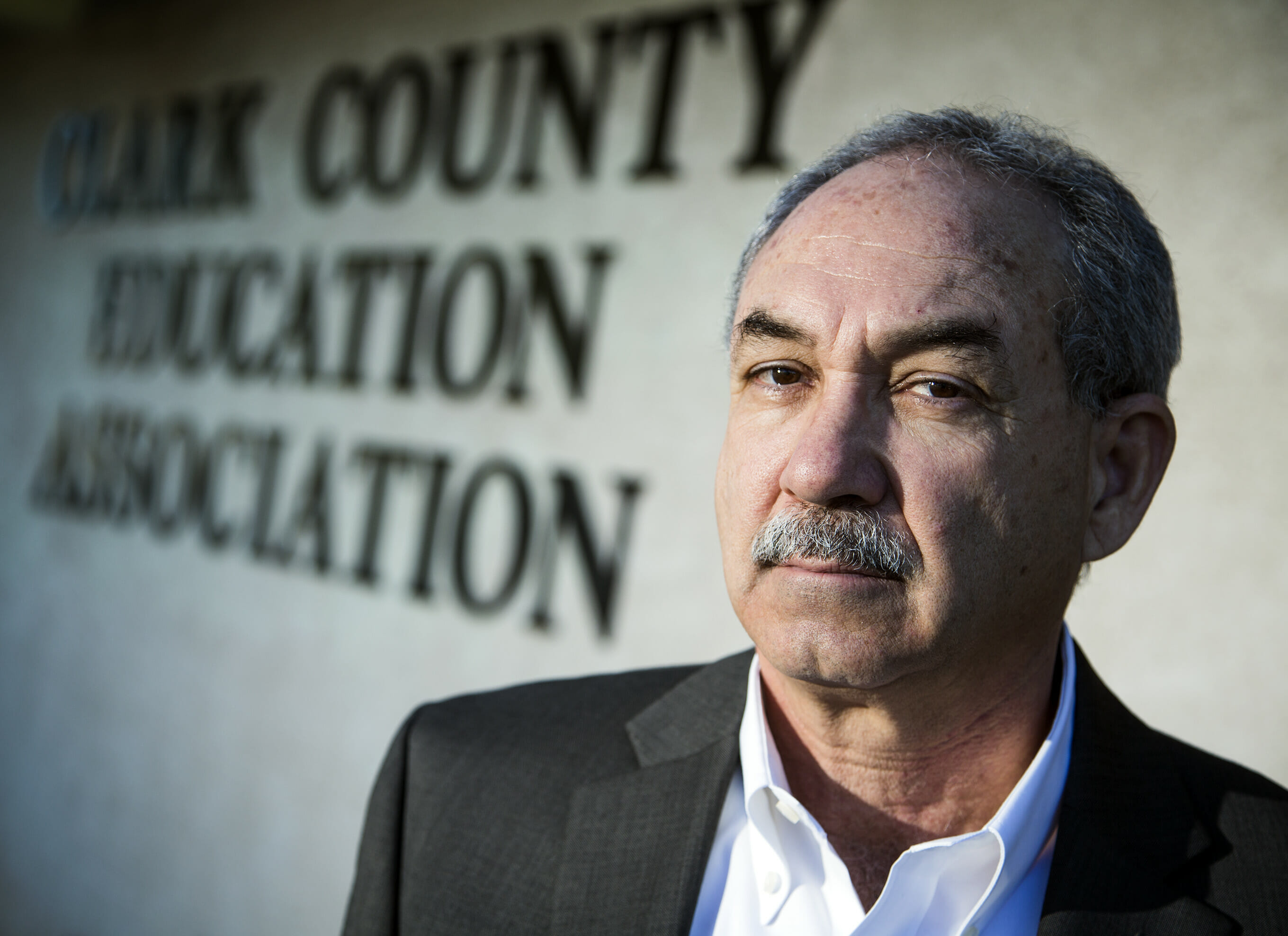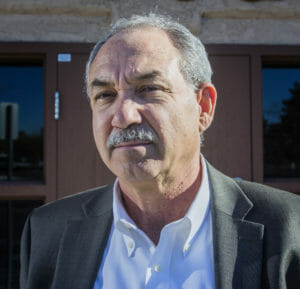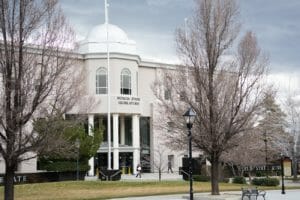Meet John Vellardita: a powerful and polarizing force in education politics

Ask John Vellardita what keeps him up at night worrying, and the executive director of Clark County’s teacher union doesn’t waste a second responding.
“Politics. It’s that simple,” he said on a recent morning inside his office, which is located around the corner from a Clark County School District building that houses school board meetings. “Politics always trumps policy, and the key is how do you manage that conversation so that policy has some sunshine on it and right decisions are made based on good policy — not politics.”
That mission, of course, relies heavily on being savvy enough to navigate the political process, which perhaps explains why Vellardita describes himself as a realist. In his five-plus years as the leader of the Clark County Education Association, which represents Southern Nevada teachers, the union leader has garnered a reputation as someone who’s willing to step across the aisle and work with both political parties to effect change that he thinks will benefit educators and, ultimately, students.
His candidness or bluntness — however you want to frame it — has created alliances with some and friction with others. It’s all the more reason to keep an eye on Vellardita as the 2017 legislative unfolds, especially given the division of power this year. Democrats control both houses of the Legislature, but they lack a two-thirds majority needed to protect against vetoes from a popular Republican governor. Plus, two controversial education issues, a weighted funding formula and voucher-style program, likely will take center stage this session as lawmakers battle over how to improve the education in the state.

Vellardita, who has become a powerful force in the Nevada education realm, will almost certainly play a large role in shaping whatever legislation comes out of this session.
“Kids deserve building upon progress made in the past to improve public education,” Vellardita said. “Politics and gridlock will suffocate and kill accomplishment, so what keeps us busy is to try to manage — to the extent we can — this kind of political dynamic.”
***
Vellardita grew up on Chicago’s South Side and said a factory job that helped pay his way through school led to his transition from a rank-and-file union member to a union leader. Along the way, Vellardita said he’s represented everyone from low-wage workers to health-care employees to, now, educators.
But his career hasn’t been without controversy, which is why his selection as the union’s new executive director in 2011 caused a stir. The Review-Journal reported that Vellardita was part of an inner group that plotted against its own union, United Health care Workers West, after receiving information that the Service Employees International Union might take the local union into trusteeship. The situation led to a federal civil lawsuit, and a jury ordered the group to pay $1.5 million in damages to the local’s parent union, according to the newspaper.
When asked about the past trouble, Vellardita offered this response: “I think my body of work since I’ve been here speaks for itself. We were very active in getting significant changes in two legislative sessions.”
In 2015, Gov. Brian Sandoval signed into law a sweeping K-12 education reform package — boosted by new and extended taxes — that funneled $343 million toward a variety of existing education programs and created some new ones as well. Zoom and Victory schools, which provide extra services for children still learning the English language and students from low-income families, respectively, benefited from the injection of new funding, as did a number of other education-related initiatives.
The legislation also allotted money for salary increases for top-performing teachers and included more controversial measures, such as the creation of the Education Savings Accounts and the Achievement School District.
While the union didn’t support all aspects of the package, Vellardita called the reinvestment in public education “unprecedented” and said Sandoval deserves more credit than he has received.
Since then, Vellardita has been a key figure in the reorganization of the Clark County School District — an outgrowth of Assembly Bill 394, which lawmakers passed in the final minutes of the 2015 legislative session.
Vellardita said it was clear during the session that lawmakers were going to pass some type of legislation to drastically alter the makeup of the school district. The union opposed any breakup of the school district, so Vellardita said he worked with Democrats and Republicans behind the scenes to craft a more favorable option. The result: A bill that wasn’t definitive and instead created a process that involved a legislative committee and a series of public meetings to develop a reorganization plan.

The plan born out of that process keeps the district intact but hands more budgeting and decision-making power to individual schools. The district is in the midst of implementing the ambitious, state-mandated reorganization.
“We’re pleased with the fact that we now have a decentralized delivery system … We think it’s a step in the right direction,” he said. “What was really nice about that whole process was you weren’t in the middle of a 120-(day) incubator where partisan politics could flare up.”
***
The strategies employed regarding the reorganization illustrate Vellardita’s philosophy, which drives the way CCEA operates at the legislative level: Work with anyone — Democrats, Republicans, business leaders and others — to get stuff done.
He eschews the notion that a union should align solely with Democrats or cling to unrealistic policy stances that, while maybe good in theory, don’t have any shot at success in the Legislature. For instance, some education groups are calling for lawmakers to conduct a robust assessment of what it actually costs to educate students of all need levels and then create a weighted funding formula based on that information. That process likely would result in a call for a massive increase in state education funding.
“I think that’s a nonstarter,” Vellardita said. “It has merit in the academic world, but, in Nevada politics, it doesn’t get anywhere.”
The teachers’ union has made the weighted funding formula, which would channel more per-pupil dollars to students with extra needs, its top focus this session. But Vellardita said the union isn’t calling for a billion-dollar investment. He thinks the discussion needs to start by examining categorical funding for programs like Zoom and Victory schools, which he called the first step in the right direction. The problem, he said, is that not all students with special needs benefit from those programs.
“If you are an (English-language learning) student but not in a Zoom School, you will not have access to additional resources and programs to ensure you have an adequate education,” he wrote in a recent blog post. “Tens of thousands of students are left out of the categorical programs. The solution is to transition categorical programs to a Weighted Funding Formula.”
The union’s stance on ESAs, which would give parents more than $5,000 to put toward education-related expenses such as private schooling or tutoring, is equally reflective of Vellardita’s tendency to acknowledge political realities. CCEA did not support the voucher-like program the Republican-controlled Legislature passed in 2015. Despite legal challenges since then, Sandoval’s proposed budget allots $60 million toward the program.
Because the governor deviated from some Republican lawmakers’ wishes and didn’t include ESAs as part of the agenda for the October special legislative session, the compromise was that it would appear in Sandoval’s budget, Vellardita said. For that reason, he considers it unavoidable but declined to elaborate much on the union’s current stance regarding ESAs.
“We’re going to be in the middle of that conversation,” he said. “We’re not going to let this thing get traded away for nothing … We’re out there saying there’s got to be a policy discussion on this issue, just as there has to be a policy discussion on the weights.”
***
The seemingly softer attitude toward ESAs lies in stark contrast to that of the union’s statewide affiliate, the Nevada State Education Association, which has strongly opposed any voucher-style program. For those immersed in the education world, it’s no secret that tensions have surfaced from time to time between Vellardita and the NSEA.
Vellardita didn’t mince words when asked about his view of the statewide union. He called NSEA President Ruben Murillo a “nice guy” but said the two organizations differ drastically in approach.
“We’re implementers,” he said. “I think we get things done because we’re engaged around policy discussion and engaged with both parties, the Department of Education, the Board of Education, the school district, the governor’s office, the business community — the list could go on and on. I think that’s a significant difference.”
Murillo declined an interview request for this story but issued a statement responding to Vellardita’s characterization of NSEA.
“When NSEA’s local affiliates are strong, it serves to fulfill NSEA’s vision for a quality public education for all students,” Murillo wrote. “NSEA, with assistance from the (National Education Association), works tirelessly to strengthen our local affiliates by providing resources as we did with CCEA and other affiliates during the 2015 legislative session and again in the current cycle.”
He continued: “NSEA’s leadership spends a great deal of time listening to our members throughout the state — from Ely to Henderson, Gardnerville to Elko. Decisions at NSEA are made from the membership up, not the top down.”
Vellardita rejects criticism that characterizes his leadership style as his way or the highway. He said the local union’s stance on issues bubbles up from the roughly 18,000 educators and licensed personnel it represents via membership surveys and committees made up of rank-and-file members. About 65 percent of eligible school district employees are CCEA members, paying yearly dues of just under $800, a union spokeswoman said.

Political leanings among the union’s members vary, with a larger number of younger educators registered as nonpartisan voters — further reason why the union shouldn’t adopt any one political party’s agenda, he said.
Although CCEA donated money mostly to Democratic candidates last year, the union also gave $2,500 each to Republicans David Gardner, Stephen Silberkraus and Derek Armstrong, according to campaign finance reports. All three lost their races. Gardner and Silberkraus were sponsors of AB 394.
The work-with-anyone mindset has helped him earn respect from Republican leaders in the Nevada Legislature. “Honestly, I was pleasantly surprised and still continue to be pleasantly surprised that he’s focused on places we can all come together and move Nevada forward,” Assembly Minority Leader Paul Anderson said. “He has a very balanced position on things.”
Senate Minority Leader Michael Roberson put things even more bluntly and described Vellardita as both a “pragmatic problem-solver” and “very strategic thinker.”
“John is the rare leader who reaches out and works with both sides of the aisle and he has no problem calling BS when he sees it, irrespective of party affiliation,” Roberson wrote in an email. “... He wants to get things done and he does. I respect that.”
The president of Nevada Succeeds, a nonprofit, nonpartisan coalition of business leaders focused on improving the state’s education system, also spoke highly of Vellardita. Brent Husson said Vellardita’s willingness to work with both parties and his dogged — or what some may perceive as aggressive — approach to get things done makes him one of the most effective education advocates. Husson has worked closely with him on a number of initiatives, including the school district reorganization and efforts to improve the state’s teacher pipeline.
“I enjoy working with him because he’s very straightforward,” Husson said. “If he wants to talk to you about something, he just does. He doesn’t couch it in nonsense.”
Vellardita said he’s not concerned if “we piss off a Republican or if we piss off a Democrat” while advocating for certain education issues. It comes with the territory, he said.
“To exercise leadership, to try to move in a direction of change, it’s not a clean path,” he said. “You will find parties and people that have strong opinions and what you try to do is navigate through those opinions and try to find consensus. That’s what we do.”
Will it work this time around in Carson City? It’s too early to tell, but Vellardita said he’s confident he can work with political leaders again to achieve progress — which he defines as ensuring that education dollars truly follow students based on their needs.
“Anything short of that would be a session of failure,” he said.
Caption: John Vellardita, executive director of the Clark County Education Association, stands in front of the CCEA office on Wednesday, Feb. 15, 2017. Photo by Jeff Scheid.
